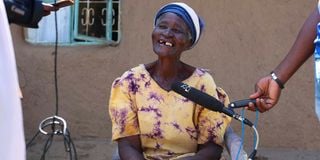Why Nyando residents bear brunt of malaria despite using mosquito nets

Ms Atieno Nyangoro during the interview in Nyando ,Kisumu County.
What you need to know:
- The latest Kenya Malaria Indicator Survey shows that over 12,000 people still die from malaria every year.
- The survey also reveals that seven in 10 Kenyans are at risk of getting malaria infection. This translates to 13 million people in the malaria endemic areas and another 19 million in the highlands where there is seasonal malaria transmission.
The lush green rice paddies covering the vast Ahero irrigation scheme in Kisumu County are a site to behold.
For years, residents have reaped big from the rice fields, which not only provide food but also employment to many. But herein lies the devil in the details — the stagnated water in the paddies acts as a playground and breeding site for mosquitoes, a great contributing factor to the high malaria prevalence in the county.
Ms Elizabeth Auma is among the residents who have grappled with recurrent malaria diagnosis on a monthly basis. When the Healthy Nation team pays Elizabeth a visit in her home in Achego, Nyando Sub-county, she is escorting her 12-year-old son to Ahero Sub-county Hospital. “My son has been complaining of high body temperatures, fatigue and lack of appetite since yesterday morning,” she says.
She explains that just two weeks ago; the child had been hospitalised at the sub-county health facility, where he was diagnosed with severe malaria.
He missed school for a week to recuperate at home. Elizabeth explains that although all her children sleep under a treated mosquito net, they keep getting malaria. "The mosquito nets only protect us at night while sleeping. But before we retire to our beds , we are always at risk of the mosquito bites.” She says that mosquitoes bred in paddies in the area begin to bite as early as 6pm.
“Those catching up with their favourite programmes on television have a choice of either buying mosquito coils or persevering the painful parasite bites. We cannot move around in our mosquito nets in the evening, it is also impossible to stay in the treated nets while watching,” she says.
Elizabeth’s neighbour, Atieno Nyang’oro, is yet another resident who hopes that the government will find a lasting solution. Her house is a few metres away from a rice paddy, and one of the canals supplying water to the fields has been constructed next to her hut.
The 73-year-old woman who has been living in the irrigation scheme since 1980 tells Healthy Nation that she just completed her malaria doses a week ago.
Despite sleeping under a treated mosquito net, Atieno says she is still at a high risk of contracting the parasitic disease while catching the evening breeze outside her house. At times while attending local events in the evening, she is forced to dress in long sleeved garments to avoid being bitten by mosquitoes.
“Whenever my grandchildren visit me, they are always in and out of the hospital due to malaria,” she adds.
According to the World Health Organization, globally in 2022, there were an estimated 249 million malaria cases and 608,000 malaria deaths in 85 countries. Africa carried the highest burden of the reported cases, with children under five years accounting for 80 per cent of deaths in the region.
The latest Kenya Malaria Indicator Survey shows that over 12,000 people still die from malaria every year.
The survey also reveals that seven in 10 Kenyans are at risk of getting malaria infection. This translates to 13 million people in the malaria endemic areas and another 19 million in the highlands where there is seasonal malaria transmission. In an effort to lower malaria infections, the Ministry of Health had early this year announced plans to distribute 15.3 million mosquito nets to high burden countries.
While the nets will benefit Kisumu among other counties, the residents of East Kano have concerns about measures put in place to protect them from the killer disease whenever they are out of bed.
Atieno says one of her biggest challenges is getting malaria treatment since the nearest health facility is many kilometres away.
“Sometimes we visit a facility only to be informed of a shortage of drugs. In such cases we have to part with extra cash and buy the drugs in private hospitals,” she says.
Immaculate Ngeso, who has three children living with Sickle Cell Disease (SCD), has seen it all. She says doctors warned that the three should not be exposed to mosquito bites due to the severe effects that malaria has on people living with sickle cell.
The National Institutes of Health notes that malaria makes SCD more severe. Immaculate says that in instances where her children get malaria infection, their blood supply is usually low, triggering a sickle cell crisis.
In efforts to lower malaria burden, Kisumu County has partnered with Rotary Club Kisumu in a pilot project to issue mosquito repellents to 200 households. Nyando Sub-county Community Health Assistant Henry Otiato says they chose Achego location following growing concerns of malaria cases due to bushy rice paddies. He notes that malaria positivity rate in the village currently ranges between 70 to 80 per cent. At the nearby Katolo health facility, 75 per cent out of the 100 per cent suspected malaria cases are always positive.
Children under the age of five are the most affected, with more than one case reported per month.
The three-month pilot project will see locals supplied with repellents for application on the exposed body areas to limit mosquito bites.
Mr Otiato notes that the programme will be upscaled to the entire Nyando Sub-county.





